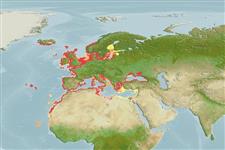>
Beloniformes (Needle fishes) >
Belonidae (Needlefishes)
Etymology: Belone: Greek, belone = needle; any fish with sharp pointed snout; also Pierre Belon, 1517-64, French zoologist born in Le Mans. Professor at the College de France, author of " La nature et diversité des poissons", 1551 (Ref. 45335).
More on author: Linnaeus.
Issue
According to authors cited by Evenhuis (1997: Ref. 115711: 480-482), the date of publication of the species should be 1760.
Environment: milieu / climate zone / depth range / distribution range
экология
морской; солоноватоводный; мигрирует в океане (Ref. 51243); пределы глубины 2 - 22 m (Ref. 130220). Temperate; 65°N - 14°N, 32°W - 42°E
Eastern Atlantic and Mediterranean Sea. Three subspecies were recognized by Collette and Parin (1970, Ref. 34977) Belone belone belone (Linnaeus, 1761) (Northeast Atlantic); Belone belone euxini Günther, 1866 (Black Sea and Sea of Azov); Belone belone acus Risso, 1827 (Mediterranean Sea and adjacent parts of Atlantic Ocean, Madeira, Canary Islands, Azores, and south to Cape Verde (Ref. 50279); subspecies Belone belone gracilis Lowe, 1839 (France to the Canary Islands including the Mediterranean) in Collette & Parin, 1990 (Ref. 5757).
Length at first maturity / Size / Вес / Возраст
Maturity: Lm ? range ? - ? cm
Max length : 104 cm TL самец/пол неопределен; (Ref. 123983); common length : 45.0 cm SL самец/пол неопределен; (Ref. 3397); наибольший вес (опубликованные данные): 1.4 kg (Ref. 113079)
колючие лучи спинного плавника (общее число) : 0; членистые (мягкие) лучи спинного плавника (общее число) : 16 - 20; членистые (мягкие) лучи анального плавника: 19 - 23. Jaw teeth comparatively large and widely spaced. Vertebrae 75-84. Vomerine teeth present at lengths greater than 20 cam. Lower jaw a little longer than upper jaw. Juveniles with greatly elongated jaw, without black posterior dorsal fin lobe.
Lives close to the surface and has a migratory pattern similar to the mackerel (Ref. 35388). Feeds on small fishes, particularly clupeids and Engraulis (in the Black Sea). Leaps out of the water when hooked. Oviparous (Ref. 205). Eggs may be found attached to objects in the water by tendrils on the egg's surface (Ref. 205). Utilized fresh and frozen; can be fried, broiled and baked (Ref. 9988). Minimum depth reported taken from Ref. 130219.
Collette, B.B. and N.V. Parin, 1986. Belonidae. p. 604-609. In P.J.P. Whitehead, M.-L. Bauchot, J.-C. Hureau, J. Nielsen and E. Tortonese (eds.) Fishes of the north-eastern Atlantic and the Mediterranean, Volume 2. Unesco, Paris. (Ref. 5505)
Статус Красного Списка МСОП (Ref. 130435)
Угроза для людей
Harmless
Использование человеком
рыболовство: коммерческий; объект спортивного рыболовства: да
дополнительная информация
инструменты
Специальные отчеты
Скачать в формате XML
ресурсы в Интернет
Estimates based on models
Preferred temperature (Ref.
123201): 8.8 - 20, mean 11.3 °C (based on 548 cells).
Phylogenetic diversity index (Ref.
82804): PD
50 = 0.6250 [Uniqueness, from 0.5 = low to 2.0 = high].
Bayesian length-weight: a=0.00105 (0.00085 - 0.00129), b=3.08 (3.02 - 3.14), in cm total length, based on LWR estimates for this species (Ref.
93245).
Trophic level (Ref.
69278): 4.2 ±0.4 se; based on diet studies.
устойчивость к внешним воздействиям (Ref.
120179): средний (среднего размера), минимальное время удвоения популяции 1.4-4.4 года (tm=2; Fec=1000).
Prior r = 0.43, 95% CL = 0.28 - 0.64, Based on 6 data-limited stock assessments.
Fishing Vulnerability (Ref.
59153): Moderate to high vulnerability (49 of 100).
Climate Vulnerability (Ref.
125649): High vulnerability (58 of 100).
Nutrients (Ref.
124155): Calcium = 50.7 [17.3, 178.7] mg/100g; Iron = 0.407 [0.148, 0.981] mg/100g; Protein = 17.8 [15.7, 20.3] %; Omega3 = 0.702 [0.293, 1.650] g/100g; Selenium = 9.33 [3.62, 22.32] μg/100g; VitaminA = 18.6 [5.4, 78.0] μg/100g; Zinc = 0.482 [0.202, 0.927] mg/100g (wet weight); based on
nutrient studies.
